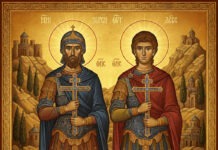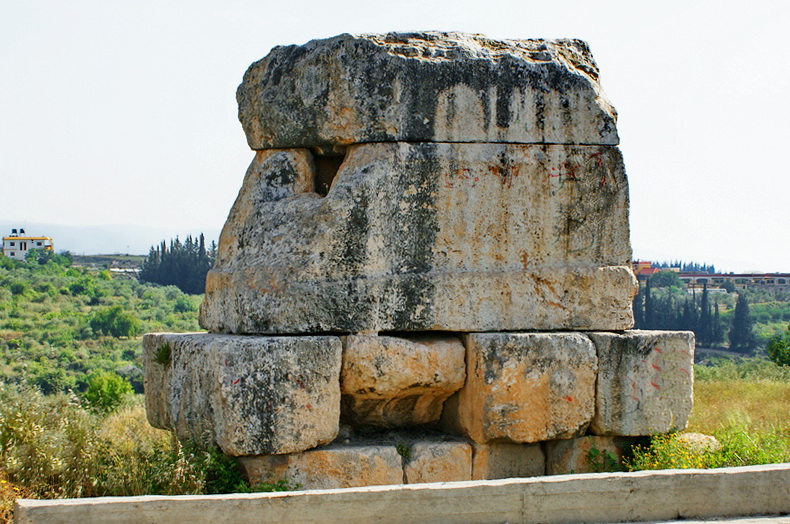What Does Phoenicia Mean & Where is it Located/The History Of Phoenicia
Picture is for King Hiram Tomb in Tyre -Lebanon
The dawn of recorded history found Lebanon inhabited by a people who it would seem called themselves the Kena’ani (Akkadian: Kinahna), “Canaanites”. Canaan was therefore earliest native name applied to the land at the eastern end of the Mediterranean. In Hebrew the word kena’ani has the secondary, and apt, meaning of “merchant”, a term which well characterizes the Phoenicians because the nature of the country and its location, forced these ancient Lebanese to turn to the sea, where they engaged in trade and navigation. The words Phoenicia and Phoenicians are thought to come from the Greek word meaning purple and refer to those Canaanites which traded in purple cloth and dye with the Greeks and lived in an area which had slightly larger borders than modern day Lebanon. It is also thought the word Phoenicia may have been derived from Phoenix, the son of Agenor, King of Tyre.
Phoenicia consisted of a mainly urban population living in a string of coastal towns and a heavily forested and mountainous hinterland. These coastal towns were to grow into cities and then into city-states. The Phoenician city-states were Ugarit, Aradus, Tripoli, Batrun, Byblos, Beirut, Sidon, and Tyre. Each of the coastal cities was an independent kingdom and had an elected council of elders to check the power of the king, these councils are the first example of democracy in history. Common interests made these cities form a Phoenician federation under the leadership of one of its cities. In the 16th century BC Ugarit headed the federation, Byblos in the 14th, Sidon in the 12th, Tyre in the 11th to the 9th and Tripoli in the 5th. These ancient Lebanese left a monumental legacy. They invented the alphabet.
The Phoenician invention of the alphabet is without doubt the greatest invention in the history of mankind. This achievement alone guaranties them a unique place in history making them the world’s greatest benefactors, but the story didn’t end there. The city of Byblos gave its name to the Bible and the Tyrian princess Europa gave her name to Europe. The Phoenicians excelled in producing textiles, in carving ivory, in working with metal, stone and wood, and above all in making glass which they also invented. They even built the temple of Solomon and mined tin in Cornwall. Masters of the art of navigation,
Phoenician ships of cedar ruled the seas, they were the first people of sail past the ‘Pillars of Hercules’ and discover Atlantic, another milestone in the history of man. The Phoenicians discovered the North Star which the Greeks were to name the Phoenician Star in honour of those that discovered it. These ancient Lebanese founded colonies wherever they went in the Mediterranean such as Cyprus, Rhodes, Crete, Malta, Sicily, Sardinia, Marseilles, Cadiz, and Carthage. Furthermore, their ships circumnavigated Africa a thousand years before those of the Portuguese.
Amongst other evidence, Phoenician inscriptions have been found in Brazil to suggest that the Phoenicians crossed the Atlantic thousands of years before Columbus. With the establishment of trade routes to Europe and western Asia, Phoenicia was to acquire wealth and position that rivalled Rome. The Phoenicians were the great pioneers of civilisation. Intrepid, inventive, enterprising, they at once made vast progress in the arts themselves, and carried their knowledge, their active habits, and their commercial instincts into the remotest regions of the old continent.
They exercised a stimulating, refining, and civilising influence wherever they went. North and south and east and west they adventured themselves amid perils of all kinds, actuated by the love of adventure more than by the thirst for gain, conferring benefits, spreading knowledge, suggesting, encouraging, and developing trade, turning men from the barbarous and unprofitable pursuits of war and bloodshed to the peaceful occupations of productive industry. They did not aim at conquest.
They united the various races of men by the friendly links of mutual advantage and mutual dependence, conciliated them, softened them, humanised them. While, among the nations of the earth generally, brute force was worshipped as the true source of power and the only basis of national repute, the Phoenicians succeeded in proving that as much could be done by arts as by arms, as great glory and reputation gained, as real a power built up, by the quiet agencies of exploration, trade, and commerce, as by the violent and brutal methods of war, massacre, and ravage. They were the first to set this example. If the history of the world since their time has not been wholly one of the potency in human affairs of “blood and iron,” it is very much owing to them. They, and their kinsmen of Carthage, showed mankind what a power might be wielded by commercial state.
History of Phoenicia On the whole Phoenician history can be reconstructed from indirect sources as the Phoenicians wrote primarily on papyrus and only a small number fragments remain. Papyrus, like paper, biodegrades and although many papyrus scrolls in Egypt survived largely by chance, because of the extremely dry climate, the situation in Lebanon was very different. Of actual Phoenician writings all that survives are a relatively small number of commemorative engravings in stone. Much of what we know comes from the writings of those with whom they traded or who, like the Greeks, were their rivals, and none too flattering in their jealousy. The Phoenicians were characterized by their chief competitors as intelligent, shrewd, cunning, proud, arrogant, mysterious, and intensely religious.
Phoenicia is mentioned in both Egyptian and Mesopotamian sources such as the tale of Wenamum and Assyrian annals which mainly refer to conquest. One important source which must have originally been direct are the annals of Tyre quoted by Josephus in certain passages from Menander of Ephesus. Another significant source is the Old Testament. The history of the Phoenicians is entwined with the history of other peoples starting with the ancient Egyptians.
Evidence of trade between Lebanon and Egypt goes back to pre-dynastic times and continued for many centuries. Lebanon provided the Nile valley with wood for palaces, temples and boats and in exchange the Canaanites received gold and other metals. This pattern of trade that had established itself over many hundreds of years was interrupted in the 18th century BC by the rise to power of a warlike people who established themselves as master of the Levant and swept down into Egypt. These were the Hyksos. The Hyksos or the ‘Shepherd Kings’ and from the names of their gods, they were undoubtedly Canaanite.
The Hyksos controlled the region for about 150 years from around 1720 to 1570 BC. The Hyksos were responsible for the introduction of the horse into the area and the use of the animal for war purposes gave them a distinct advantage in battle, they introduced the horse-drawn chariot and the composite bow, and their successful conquests were furthered by a type of rectangular fortification of beaten earth used as a fortress; archaeologists have uncovered examples of these mounds at Jericho, Shechem, and Lachish. Their most important contribution was perhaps the introduction into Egypt of Canaanite deities and Asian artifacts.
Hyksos rule was broken by a Theban prince, Ahmose, who drove the invaders out of Egypt and started his country on its new career of empire building. Over the next few hundred years the Egyptian empire not only included Lebanon but reached as far as the Euphrates. At the turn of the 14th century BC however, the empire began to decline and in the north a new world power emerged, the Hittites. The Hittites, a people of Indo-European connection, were supposed to have entered Cappadocia c.1800 B.C. To the southwest, in the Taurus and Cilicia, were the Luites, relatives of the Hittites; to the southeast, in the Upper Euphrates, the Hurrians (Khurrites). In the country the Hittites then occupied, the aboriginal inhabitants were apparently the Khatti, or Hatti.
Hittite names appear c.1800 B.C. on the tablets written by Assyrian colonists at Kültepe (Kanesh) in Cappadocia. However, real evidence of Hittite existence does not occur until the Old Hittite Kingdom (1600–1400 B.C.). The Hittites tried to invade Babylonia but were halted by Egypt and Mitanni. The Hittite Empire that followed the Old Kingdom, with its capital at Bogazköy (also called Hattusas), was the chief power and cultural force in western Asia from 1400 to 1200 B.C. The famous Hittite rulers date from this period.
Among these are Supiluliumash (fl. 1380 B.C.) who is mentioned in the Tel el Amarna letters, Mursilish II (fl. 1335 B.C.), and Hattusilish III (fl. 1300 B.C.). The Hittite Empire was a loose confederation that started to break up under the invasions of the Thracians, Phrygians, and Assyrians from c.1300 B.C. Several small states arose, with Carchemish becoming an outstanding city. It was at the turn of the 13th century BC when both the Egyptian and Hittite powers were on the decline and the Assyrians had not yet risen that Phoenicia was able to assert its full independence. It was the next few hundred years of relative peace that saw Phoenicia enter its golden age of prosperity based on increased international trade and colonization. Assyrian greatness was to wait until the 9th century, when Ashurnasirpal II came into power.
He was not only a vigorous and barbarously cruel conqueror who pushed his conquests N to Urartu and W to Lebanon and the Mediterranean, but he was also a shrewd administrator. Instead of merely making conquered kings pay tribute, he installed Assyrian governors so that he could have more control over the empire. Shalmaneser III attempted to continue this policy, but, although he exacted heavy tribute from Jehu of Israel and claimed many victories, he failed to establish hegemony over the Hebrews and their Aramaic-speaking allies.
A basalt obelisk, called the Black Obelisk, now in the British Museum, describes the expeditions and conquests of Shalmaneser III. Raids from Urartu were resumed and grew more destructive after the death of Shalmaneser. Calah, the capital of Assyria during the reigns of Ashurnasirpal II and Shalmaneser III, has been excavated. In the 8th century B.C. conquest was pursued by Tiglathpileser III. He subdued Babylonia, defeated the king of Urartu, attacked the Medes, and established control over Syria. As an ally of Ahaz of Judah, who became his vassal, he defeated his Aramaic-speaking enemies centering at Damascus. His successor, Shalmaneser V, besieged Samaria, the capital of Israel, in 722–721 B.C., but it was Sargon, his son,
who completed the task of capturing Israel. Sargon’s victory at Raphia (720 B.C.) and his invasions of Armenia, Arabia, and other lands made Assyria indisputably one of the greatest of ancient empires. Sargon’s son Sennacherib devoted himself to retaining the gains his father had made. He is particularly remembered for his warfare against his rebellious vassal, Hezekiah of Judah. Sennacherib’s successor, Esar-Haddon (Esarhaddon), on his accession, found Abd-Melkarth of Sidon in revolt against his authority. He had formed an alliance with a certain Sanduarri, king of Kundi and Sizu, a prince of the Lebanon, and had set up as independent monarch, probably during the time of the civil way which was waged between Esarhaddon and two of his brothers who disputed his succession after they had murdered his father. As soon as this struggle was over, and the Assyrian monarch found himself free to take his own course, he proceeded at once (B.C. 680) against these two rebels. Both of them tried to escape him.
Abd-Melkarth, quitting his capital, fled away by sea, steering probably either for Aradus or for Cyprus. Sanduarri took refuge in his mountain fastnesses. But Esarhaddon was not to be baffled. He caused both chiefs to be pursued and taken. “Abd-Melkarth,” he says, “who from the face of my solders into the middle of the sea had fled, like a fish from out of the sea, I caught, and cut off his head . . . Sanduarri, who took Abd-Melkarth for his ally, and to his difficult mountains trusted, like a bird from the midst of the mountains, I caught and cut off his head.” Sidon was very severely punished. Esarhaddon boasts that he swept away all its subject cities, uprooted its citadel and palace, and cast the materials into the sea, at the same time destroying all its habitations. The town was plundered, the treasures of the palace carried off, and the greater portion of the population deported to Assyria. An Assyrian general was placed as governor over the city, and its name changed from Sidon to “Ir-Esarhaddon.”
Under Esarhaddon’s son, Assurbanipal, Assyria reached its zenith and approached its fall. Assurbanipal’s reign saw the Assyrian capital of Nineveh reach the height of its splendor. The library of cuneiform tablets he collected ultimately proved to be one of the most important historical sources of antiquity. The magnificent Assyrian bas-reliefs reached their peak. The royal court was luxurious. Assyrian culture owed much to earlier Babylonian civilization, and in religion Assyria seems to have taken much from its southern neighbor and subject. Despite the magnificence of Assurbanipal’s court, Assyria began a rapid decline during his reign. The military aspect of the empire was its most prominent feature, for Assyria was prepared for conflict from beginning to end. Because of the ever-present need for men to fight the constant battles, agriculture suffered, and ultimately the Assyrians had to import food. The lavish expenditures of Assurbanipal on warfare and building drained the resources of the empire and contributed to its weakness.
When Assurbanipal was fighting against the Chaldaeans and Elamites, an Egyptian revolt under Psamatik I (Psamtik I) was successful. Psamatik I., who was advanced in years at the time of Assyria’s downfall, died about B.C. 610, and was succeeded by a son still in the full vigour of life, the brave and enterprising Neco. Neco, in B.C. 608, having made all due preparations, led a great expedition into Palestine, with the object of bringing under his dominion the entire tract between the River of Egypt (Wady el Arish) and the Middle Euphrates. Soon all of Palestine, Phoenicia, and Syria were overrun, and became temporarily Egyptian possessions. Phœnicia does not appear to have been subdued by force. Tyrian prosperity continued, and the terms on which Phœnicia stood towards Egypt during the remainder of Neco’s reign were friendly. Phœnicians at Neco’s request accomplished the circumnavigation of Africa; and Neco granted to Tyre the extraordinary favour of settling a colony in the Egyptian capital, Memphis.
The glory and prosperity which Egypt had thus acquired were very short-lived. Within three years Babylonia asserted herself. In B.C. 605, the crown prince, Nebuchadnezzar, acting on behalf of his father, Nabopolassar, who was aged and infirm, led the forces of Babylon against the audacious Pharaoh, who had dared to affront the “King of kings,” “the Lord of Sumir and Accad,” had taken him off his guard, and deprived him of some of his fairest provinces. Babylonia, under Nabopolassar and Nebuchadnezzar, was a worthy successor of the mighty power which for seven hundred years had held the supremacy of Western Asia. Her citizens were as brave; her armies as well disciplined; her rulers as bold, as sagacious, and as unsparing. Habakkuk’s description of a Babylonian army belongs to about this date — “Lo,
I raise up the Chaldæans, that bitter and hasty nation, which shall march through the breadth of the land, to possess the dwelling-places that are not theirs. They are terrible and dreadful; from them shall proceed judgment and captivity; their horses are swifter than leopards, and are more fierce than the evening wolves; and their horsemen shall spread themselves, and their horsemen shall come from far; they shall fly as the eagle that hasteth to eat. They shall come all for violence; their faces shall sup as the east wind, and they shall gather the captivity as the sand. And they shall scoff at kings, and princes shall be a scorn unto them; they shall derive every stronghold; for they shall heap dust, and take it.”
Early in the year B.C. 605 the host of Nebuchadnezzar appeared on the right bank of the Euphrates, moving steadily along its reaches, and day by day approaching nearer and nearer to the great fortress in and behind which lay the army of Neco, well ordered with shield and buckler, its horses harnessed, and its horsemen armed with spears that had been just furbished, and protected by helmets and brigandines. One of the “decisive battles of the world” was impending. We have no historical account of the great battle of Carchemish. Jeremiah, however, beholds it in vision. He sees the Egyptians “dismayed and turned away back–their mighty ones are beaten down, and are fled apace, and look not back, since fear is round about them.”
He sees the “swift flee away,” and the “mighty men” attempting to “escape;” but they “stumble and fall toward the north by the river Euphrates. For this is the day of the Lord God of hosts, a day of vengeance, that He may avenge Him of His adversaries; and the sword devours, and it is satiate and made drunk with their blood, for the Lord God of hosts hath a sacrifice in the north country by the river Euphrates.” The “valiant men” are “swept away…many fall, yea, one falls upon another, and they say, Arise and let us go again to our own people, and to the land of our nativity from the oppressing sword. Nor do the mercenaries escape. Her hired men are in the midst of her, like fatted bullocks; for they also are turned back, and are fled away together; they did not stand because the day of their calamity was come upon them, and the time of their visitation.” The defeat was, beyond a doubt, complete, overwhelming.
The shock of it was felt all over the Delta, at Memphis, and even at distant Thebes. The hasty flight of the entire Egyptian host left the whole country open to the invading army. “Like a whirlwind, like a torrent, it swept on. The terrified inhabitants retired into the fortified cities,” where for the time they were safe. Nebuchadnezzar did not stop to commence any siege. He pursued Neco up to the very frontier of Egypt, and would have continued his victorious career into the Nile valley, had not important intelligence arrested his steps.
His aged father had died at Babylon while he was engaged in his conquests, and his immediate return to the capital was necessary, if he would avoid a disputed succession. Thus matters in Syria had to be left in a confused and unsettled state, until such time as the Great King could revisit the scene of his conquests, and place them upon some definite and satisfactory footing. On the whole, the campaign had, apparently, the effect of drawing closer the links which united Phœnicia with Egypt. Babylon had shown herself a fierce and formidable enemy, but had disgusted men more than she had terrified them. It was clear enough that she would be a hard mistress, a second and crueller Assyria.
There was thus, on Nebuchadnezzar’s departure, a general gravitation of the Syrian and Palestinian states towards Egypt, since they saw in her the only possible protector against Babylon, and dreaded her less than they did the “bitter and hasty nation.” Neco, no doubt, encouraged the movement which tended at once to strengthen himself and weaken his antagonist; and the result was that, in the course of a few years, both Judæa and Phœnicia revolted from Nebuchadnezzar, and declared themselves independent. Phœnicia was still under the hegemony of Tyre, and Tyre had at its head an enterprising prince, a second Ithobal, who had developed its resources to the uttermost, and was warmly supported by the other cities.
His revolt appears to have taken place in the year B.C. 598, the seventh year of Nebuchadnezzar. Nebuchadnezzar at once marched against him in person. The sieges of Tyre, Sidon, and Jerusalem were formed. Jerusalem submitted almost immediately. Sidon was taken after losing half her defenders by pestilence; but Tyre continued to resist for the long space of thirteen years.
The continental city was probably taken first. Against this Nebuchadnezzar could freely employ his whole force–his “horses, his chariots, his companies, and his much people”–he could bring moveable forts close up to the walls, and cast up banks against them, and batter them with his engines, or undermine them with spade and mattock. When a breach was effected, he could pour his horse into the streets, and ride down all opposition. It is the capture of the continental city which Ezekiel describes when he says: “Thus saith the Lord God: Behold, I will bring upon Tyrus Nebuchadnezzar, king of Babylon, a king of kings, from the north, with horses and with chariots, and with horsemen, and companies, and much people.
He shall slay with the sword thy daughters in the field; and he shall make a fort against thee, and cast a mount against thee, and lift up the buckler against thee. And he shall set engines of war against thy walls, and with his axes he shall break down thy towers. By reason of the abundance of his horses, their dust shall cover thee; thy walls shall shake at the noise of the horseman, and of the wheels and of the chariots, when he shall enter into thy gates, as men enter into a city wherein is made a breach. With the hoofs of his horses shall he tread down all thy streets: he shall slay thy people by the sword, and thy strong garrisons shall go down to the ground. And they shall make a spoil of thy riches, and make a prey of thy merchandise; and they shall break down thy walls, and destroy thy pleasant houses: and they shall lay thy stones and thy timber and thy dust in the midst of the water.” But the island city did not escape.
When continental Phœnicia was reduced, it was easy to impress a fleet from maritime towns; to man it, in part with Phœnicians, in part with Babylonians, no mean sailors, and then to establish a blockade of the isle. Tyre may more than once have crippled and dispersed the blockading squadron; but by a moderate expenditure fresh fleets could be supplied, while Tyre, cut off from Lebanon, would find it difficult to increase or renew her navy.
There has been much question whether the island city was ultimately captured by Nebuchadnezzar or no; but even writers who take the negative view admit that it must have submitted and owned the suzerainty of its assailant. The date of the submission was B.C. 585. Phœnicia under the Babylonian rule was exceptionally weak. She had to submit to attacks from Egypt under Apries, which fell probably in the reign of Baal over Tyre, about B.C. 565. She had also to submit to the loss of Cyprus under Amasis, probably about B.C. 540, or a little earlier,
when the power of Babylon was rapidly declining. She had been, from first to last, an unwilling tributary of the Great Empire on the Lower Euphrates, and was perhaps not sorry to see that empire go down before the rising power of Persia. Under the circumstances she would view any chance as likely to advance her interests, and times of disturbance and unsettlement gave her the best chance of obtaining a temporary independence.
From B.C. 538 to B.C. 528 or 527 she seems to have enjoyed one of these rare intervals of autonomy. Egypt, content with having annexed Cyprus, did not trouble her; Persia, engaged in wars in the far East, made as yet no claim to her allegiance. In peace and tranquillity she pursued her commercial career, covered the seas with her merchant vessels, and the land-routes of trade with her caravans, repaired the damages inflicted by Nebuchadnezzar on her cities; maintained, if she did not even increase, her naval strength, and waited patiently to see what course events would take now that Babylon was destroyed by Cyrus the Great the great-grandson of Cyaxares, the king of the Medes, and a new and hitherto unknown power, Persia, was about to assume the first position among the nations of the earth.
The empire founded by Cyrus (550-530) was stretched by his successors from the Hindu Kush and beyond the Indus to the Aegean, and from the Caucasus to the Indian Ocean, the greatest thus far. The Persians were Indo-Europeans, closer to the Greeks and Romans than to the Semites. They followed a more centralized system of political control than their imperial predecessors. To that end they linked the far-flung parts of the empire with a system of roads, introduced metallic currency and made Aramaic, a Semitic language, the lingua franca of the realm. Lebanon, Syria, Palestine and Cyprus were grouped in one satrapy (province).
Sidon was chosen as the capital. The city was provided with a royal residence for the Persian satrap and for the emperor when on a state visit. Sidon, Tyre, Byblus and Aradus, however, were allowed a measure of autonomy, including issuance of their own coinage. Phoenician cities materially profited by the Pax Persica and the new facilities of communication. Their seemingly inexhaustible supply of cedar wood, though now a state domain, continued to be a source of revenue. Their fleet, the largest and best equipped in the eastern Mediterranean, was in demand by Persian warring emperors. Without it Cambyses could not have conquered Egypt (525). But when that emperor sought their aid against the Cartha- ginians, they flatly refused, as they “would not attack their own sons”.
Their response to fight the Greeks, however, was enthusiastic, as they saw in it an opportunity to damage the potential of their commercial maritime rivals. The Greco-Persian wars have been characterized as a contest between Phoenician and Greek sea powers. In the prolonged struggle over two hundred Phoenician ships participated, transporting Persian troops back and forth shuttling among Aegean islands and taking part in such world-renowned battles as those of Miletus (494) and Salamis (480). A Greek historian awarded the prize of valour to the Athenians for the Greeks and “to the Sidonians for the barbarians”.
Phoenician engineers helped build the pon- toon bridge across the Hellespont, over which Xerxes’ army crossed to Europe, and dig the canal through the isthmus joining Mount Athos to the mainland. For about a century and three-quarters Perse-Phoenician relations seemed to have been cordial. But by 360 a change began. Greco-Phoenician relations entered on a new phase. Sidonians in Attica were exempted by Athenians from the usual tax on foreigners, and the number of Phoenicians in Piraeus and other cities greatly increased. A king of Sidon, Straton by name, became known as Philhelene (pro-Greek). The Lebanese must have sensed that the Persian sun was on its way to setting and resented more than before the arrogant attitude of such satraps as those ofArtaxerxes III (359-338). The spark this time was kindled in a Tripoli. The city consisted of three separate settlements of Sidonians, Tyrians and Aradians.
The insurrection started in the Sidonian quarter but soon spread to involve the entire coast. The mother-city Sidon, under its king Tennes, assumed leadership. Egypt contributed the usual encouragement. Nine leading cities expelled their satraps and declared their full independence. Artaxerxes reacted vigorously. At the head of a mighty host of 300,000 foot, 30,000 horse and 300 triremes he moved in 350 BC against Sidon. Tennes lost heart. He betrayed the city but did not escape death. Five hundred Sidonian notables carrying the olive branches were shot down by the Persian emperor.
The bulk of the people, however, resolved to die as free men. In desperation they set all the ships in the harbour on fire, leaving no way of escape and shut themselves in their homes to be consumed along with their possessions by the raging fire. More than 40,000 are said to have perished. The few thousand survivors were carried away into captivity. Once the mistress of the sea the city was now a heap of ashes. For the second time in its history Sidon was wiped off the face of the map, the first time being by the hand of Esarhaddon in 680 BC. The Persian hold on the coast, bought at such high costs was short lived. In eighteen years the entire empire was to crumble under the blows of an unexpected invader from the west.
When in the spring of 334 B.C. a twenty year old Macedonian led an army of 35,000 across the Hellespont, neither he nor anyone else could have foreseen that the map of the Near East was soon to be redrawn and the course of its history changed. The general’s name was Alexander the Great. The march through Asia Minor, then in Persian hands, amounted to a promenade. At Issus, a narrow defile in north Syria, skill and discipline counterbalanced numerical superiority; the motley host of Darius III was shattered (333). The emperor had a narrow escape, leaving even his harem behind.
The Macedonian phalanx had been developed by the general’s father, Philip, under whom the kingdom attained hegemony over Greece. Alexander’s spectacular victory was commemorated by building Alexandretta (Iskandarun), a harbinger of unnumbered cities to be built by him and by his successors. The way was now open through Lebanon to Egypt. Aradus, Byblus, Sidon and other ports willingly exchanged masters. Only Tyre, former defier Nebuchadnezzar, dared hold out. Alexander the Great, took Tyre only after a long and hard siege (333–332 BC) making the siege of Tyre one of the most dramatic of antiquity.
In the division of Alexander’s empire, which followed upon his death, Phœnicia was at first assigned, together with Syria, to Laemedon, and the two formed together a separate satrapy. But, after the arrangement of Triparadisus (B.C. 320), Ptolemy Lagi almost immediately attacked Laemedon, dispossessed him of his government, and attached it to his own satrapy of Egypt. Six years later (B.C. 314), attacked in his turn by Antigonus, Ptolemy was forced to relinquish his conquests, none of which offered much resistance except Tyre. Tyre, though no more than eighteen years had elapsed since its desolation by Alexander, had, like the fabled phœnix, risen again from its ruins, and through the recuperative energy of commerce had attained almost to its previous wealth and prosperity.
Its walls had been repaired, and it was defended by its Egyptian garrison with pertinacity. Antigonus, who was master of the Phœnician mainland, established dockyards at Sidon, Byblus, and Tripolis, set eight thousand sawyers and labourers to cut down timber in Lebanon, and called upon the kings of the coast towns to build him a fleet with the least possible delay. His orders were carried out, and Tyre was blockaded by sea and land for the space of fifteen months, when the provisions failed and the town was forced to surrender itself.
The garrison marched out with the honours of war, and Phœnicia became an appendage of the small empire of Antigonus. From Antigonus Phœnicia passed to his son Demetrius, who maintained his hold on it, with some vicissitudes of fortune, till B.C. 287, when it once more passed under the dominion of Ptolemy Lagi. From this time it was an Egyptian dependency for nearly seventy years, and flourished commercially, if it not distinguish itself by warlike exploits. The early Ptolemies were mild and wise rulers. They encouraged commerce, literature, and art. So far as was possible they protected their dominions from external attack, put down brigandage, and ruled with equity and moderation.
It was not until the fourth prince of the house of Lagus, Philopator, mounted the throne (B.C. 222) that the character of their rule changed for the worse, and their subjects began to have reason to complain of them. The weakness and profligacy of Philopater tempted Antiochus III. to assume the aggressive, and to disturb the peace which had now for some time subsisted between Syria and Egypt, the Lagidæ and the Seleucidæ. In B.C. 219 he drove the Egyptians out of Seleucia, the port of Antioch, and being joined by Theodotus, the Egyptian governor of the Cœlesyrian province, invaded that country and Phœnicia, took possession of Tyre and Accho, which was now called Ptolemaïs, and threatened Egypt with subjugation.
Phœnicia once more became the battle-field between two great powers, and for the next twenty years the cities were frequently taken and re-taken. At last, in B.C. 198, by the victory of Antiochus over Scopas, and the surrender of Sidon, Phœnicia passed into the permanent possession of the Seleucidæ, and, though frequently reclaimed by Egypt, was never recovered. The kingdom of the Seleucidæ came to an end through its own internal weakness and corruption. In B.C. 83 their subjects, whether native Asiatics or Syro-Macedonians, were so weary of the perpetual series of revolts, civil wars, and assassinations that they invited Tigranes, the king of the neighbouring Armenia, to step in and undertake the government of the country.
Tigranes ruled from B.C. 83 till B.C. 69, when he was attacked by the Romans, to whom he had given just cause of offence by his conduct in the Mithridatic struggle. Compelled by Lucullus to relinquish Syria, he retired to his own dominions, and was succeeded by the last Seleucid prince, Antiochus Asiaticus, who reigned from B.C. 69 to B.C. 65. Rome then stepped forward, and took the inheritance to which she had become entitled a century and a quarter earlier by the battle of Magnesia. Phoenicia thus passed quietly into the Roman Empire.
Phoenicia gained greatly by the strictness with which Rome kept the police of the Eastern Mediterranean. For many years previously to B.C. 67 their commerce had been preyed upon to an enormous extent by the piratical fleets, which from the creeks and harbours of Western Cilicia and Pamphylia, spread terror and made the navigation of the Levant and Ægean a dangerous business. Pompey, in that year, completely destroyed the piratical fleets, attacked the pirates in their lairs, and cleared them out from every spot where they had established themselves.
Voyages by sea became once more as safe as travels by land; and a vigilant watch being kept on all the coasts and islands, piracy was never again permitted to gather strength, or become a serious evil. The Phœnician merchants could once more launch their trading vessels on the Mediterranean waters without fear of their suffering capture, and were able to insure their cargoes at a moderate premium. The cities of Tripoli, Sidon, and Tyre were given the position of “free cities” which secured them an independent municipal government, under their own freely elected council and chief magistates. These privileges, conferred by Pompey, were not withdrawn by Julius Cæsar, when he became master of the Roman world.




















